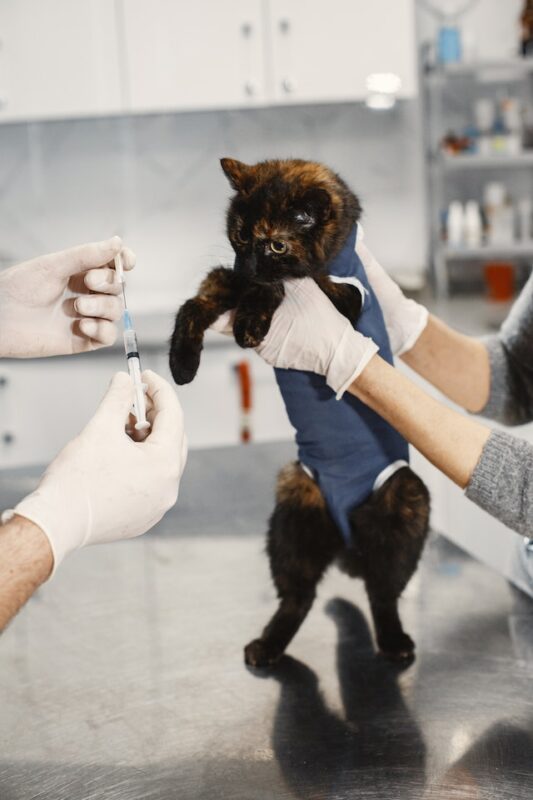Scratchpay Vet Payments VS Pet Insurance
Posted: 06/29/2023 | BY: Jenna Bruce | Categories: Cat , Consumer , Dog , Health problems
If you have a pet companion you most likely know that caring for them is very expensive! In fact, according to the American Pet Products Association (APPA) Americans spent a record-breaking $136.8 billion on our pets in 2022 alone! Much of this cost boils down to vet care, particularly emergency pet care. Unlike medical care for people, most emergency procedures for our pets are withheld unless and until the pet parent pays upfront. Which brings us to a common debate: Scratchpay Vet Payments VS Pet Insurance – is one better than the other in a medical emergency situation?

Scratchpay Vet Payments – A Web-Based Veterinary Financing Service
According to a recent Banrate report, 6 in 10 Americans don’t have enough savings to cover the cost of an emergency vet visit. This scenario presents pet parents with a heartbreaking decision: Somehow scrape together the cash – and do it within hours or even minutes – or say goodbye to your precious family member.
It’s for this very reason that Scratchpay Vet was born. Scratchpay is a web-based veterinary-financing service that helps pet parents pay their high vet bills. Private veterinary lending is actually a fairly new form of lending offered by some vet clinics and emergency hospitals. These loans function similarly to a traditional line of credit or credit card. In fact, CareCredit is a well-known example of a veterinary-financing service. You can hand this card over to someone at the emergency clinic and as long as you have enough credit to cover costs, the payment will go through immediately and without any need of paperwork.
Scratchpay Vet works a little bit differently. You don’t actually carry a credit card in your wallet, like you do with CareCredit. Scratchpay is actually a short-term loan. Each time you are faced with a significant vet bill, you simply apply for a loan right then and there online (it only takes a few minutes) and the bill is paid in full.
ScratchPay Vet Payments Pros and Cons
Let’s start with the obvious pro: you’ll be able to get a line of credit in an emergency to pay for your fur baby’s care – perhaps life-saving care.
Now for the cons…
It’s a loan, so your credit and income will come into play to determine if you’re eligible and if so, for how much. Those with good credit scores and a solid income won’t have much to worry about but those with low income and credit may have some issues.
Perhaps the biggest con is that, like any other line of credit or loan, there will be varying rates of interest. If your credit is poor or if the economic climate is such that interest rates continue to rise, you may be looking at hefty monthly payments to pay back this loan.

How Does Pet Insurance Work?
With pet insurance, you pay a monthly premium for your coverage. Each policy specifies the conditions and expenses covered, your reimbursement rate, your deductible and the annual maximum payout (if there is one).
Most pet insurance works by reimbursing the pet parents for a portion of the expenses instead of paying the vet directly. The good thing about this is you never have to worry about finding an “in-network” provider. This means even if you are on vacation somewhere and your pup gets sick, you can use your pet insurance at any licensed clinic.
It should be mentioned that there are a handful of pet insurance companies that pay vets directly.
So how exactly do you get payment from the insurance provider? Once your bill has been paid by you, you simply submit a claim, wait a period of usually 5 – 7 business days (though some companies pay within 48 hours), and receive a payment that covers anywhere from 70% to 100% of the bill (after your deductible is met).
Pet Insurance Pros and Cons
The obvious con with pet insurance is that you must have either savings or a line of credit to pay those costs upfront.
And the obvious pro is that you can get up to 100% of your vet bill covered once you submit your claim. That means no monthly payments and no high interest rates.
So how much does pet insurance cost each month? That really depends on a variety of factors including the species of your pet, age and your zip code. What we can say is that average monthly premiums are around $29 for a cat and $45 for a dog. However you can find flexible pricing options that can get your monthly premium down. For instance, if you choose a higher deductible and a lower reimbursement rate, you can find a policy that only costs $12 a month. Then again, you can choose to have the most coverage with 100% of your bill covered and you may end up paying $75 a month. It’s really up to what you can comfortably afford each month.

In An Ideal World…
In an ideal world a pet parent would have Scratchpay Vet, CareCredit or their own credit card to pay the initial vet bill, and then they would have a pet insurance policy to reimburse them so they can pay off that card almost immediately. This really is the best case scenario because you have the funds to get your pet the care they need, and then you also have a way of reducing your vet bill by 90% or more.
Take 2 minutes right now to get a free customized quote from multiple insurance providers. You’ll be thankful for the peace of mind should an accident or serious illness occur.
References:
- https://www.americanpetproducts.org/press_industrytrends.asp “Pet Industry Market Size, Trends & Ownership Statistics”
- https://www.bankrate.com/banking/savings/emergency-savings-report/ “Bankrate’s 2023 annual emergency savings report”
Disclaimer
The information contained on this blog is intended for informational and educational purposes only and should not be construed as medical advice. It is not a substitute for professional veterinary care. Always consult with your veterinarian before making any changes to your pet's health care or treatment plan.
The authors of this blog are not veterinarians and do not claim to be experts in pet health. The information provided here is based on our own experiences and research, as well as information from reputable sources. However, we cannot guarantee the accuracy or completeness of this information.
We encourage you to do your own research and consult with your veterinarian before making any decisions about your pet's health.
Previous post
Best Dog Food for Heart HealthNext post
Cold Laser Therapy for Dogs?Compare top pet insurance providers plans.
Enter your dog’s age in years and months to calculate their age equivalent to human years.
Calculate your dog’s ageEnter your cat’s age in years and months to calculate their age equivalent to human years.
Calculate your cat’s age